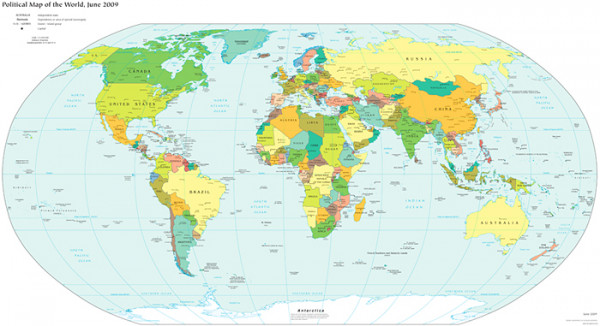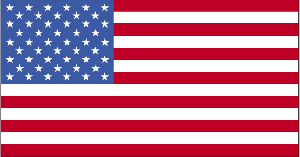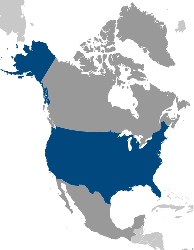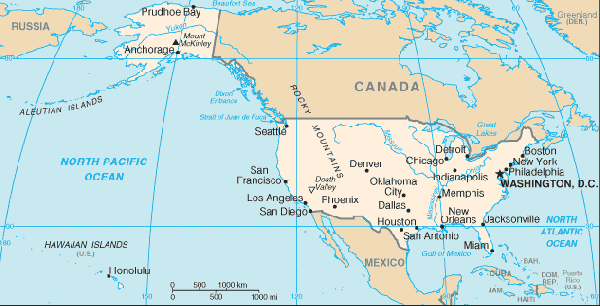The United States of America (USA)
Overview
| Flag |
|
| Anthem |
The Star-Spangled Banner
Watch on youtube (with lyrics)
|
| Capital |
Washington, D.C. |
| Largest city |
New York City |
| National language |
English (de facto) |
| Ethnic groups |
~ 79.8% White / ~ 12.8% African American / ~ 4.5% Asian American / ~ 1.0% Native American and Alaska Native / ~ 0.2% Native Hawaiian and Pacific Islander / ~ 1.7% Multiracial / ~ 15.4% Hispanic (of any race) |
Demonyma name for a resident of a locality, often the same as the name of the people's native language
|
American |
| Government |
Federal constitutional presidential republic |
| Area |
9,826,675 km2, 3,794,101 sq mi |
| Population |
~ 309,3 million |
| Currency |
United States dollar ($) (USD) |
| Internet TLD |
.us / .gov / .mil / .edu |
Geography
The USA comprise fifty states and a federal district. The country is situated mostly in central North America, where its forty-eight
contiguousconnecting without a break states and Washington, D.C., the capital district, lie between the Pacific and Atlantic Oceans, bordered by Canada to the north and Mexico to the south. The state of Alaska is in the northwest of the continent, with Canada to the east and Russia to the west across the
Bering Straita sea strait between the easternmost point of the Asian continent and the westernmost point of the North American continent. The state of Hawaii is an
archipelagoa group of islands in the mid-Pacific. At 3.79 million square miles (9.83 million km2), the United States is the third largest country by total area.
The capital of the United States is Washington, D.C., commonly referred to as Washington, the District, or simply D.C. The city shares its name with the U.S. state of Washington on the country's Pacific coast. The District has a resident population of 599,657; because of
commutersperson who regularly travels from one place to another, typically to work from the surrounding
suburbsthe area on the periphery of a city or large town that falls between being truly part of the city, but is not countryside either, its population rises to over one million during the workweek. The most populous city in the USA is New York City. As a leading global city, New York
exertsto make use of, to apply, especially of something non-material a powerful influence over global commerce, finance, media, culture, art, fashion, research, education, and entertainment. The city's 2008
estimatedrough calculation or guess population exceeded 8.3 million. Some other large cities in the USA are Los Angeles and Chicago.
Society and culture
The United States is a multicultural nation, home to a wide variety of ethnic groups, traditions, and values. Aside from the now small Native American and Native Hawaiian populations, nearly all Americans or their
ancestorsone from whom a person is descended, whether on the father's or mother's side, at any distance of time, a fore father immigrated within the past five
centuriesa period of 100 consecutive years. The culture held in common by most Americans is a Western culture largely derived from the traditions of European immigrants with influences from many other sources, such as traditions brought by
slavesperson who is the property of another person and whose labour and also whose life often is subject to the owner's volition from Africa.
Population
The United States population is projected by the U.S. Census Bureau to be 309,411,000, including an estimated 11.2 million illegal immigrants. In 2009, 1.1 million immigrants were granted legal residence. The United States has a very diverse population. White Americans are the largest racial group; German Americans, Irish Americans, and English Americans
constituteto make up, to compose, to form three of the country's four largest ancestry groups. African Americans are the nation's largest racial
minorityany subgroup that does not form a numerical majority. Asian Americans are the country's second largest racial minority; the two largest Asian American ethnic groups are Chinese American and Filipino American. There are 46.9 million Americans of Hispanic descent. Minorities (all those beside non-Hispanic, non-multiracial whites) constitute 34% of the population.
Languages
English is the national language. In 2006, about 224 million, or 80% of the population aged five years and older, spoke only English at home. Spanish, spoken by 12% of the population at home, is the second most common language and the most widely taught second language. In Hawaii, both Hawaiian and English are official languages. Louisiana has laws
providingto make possible for the use of both English and French.
Religion
The United States is officially a
secularnot specifically religious nation; the First
Amendmentan addition or alteration to the Constitution of the U.S. Constitution guarantees the free exercise of religion. According to a 2007 survey, 78.4% of adults identified themselves as Christian. Protestant
denominationsa class or society of individuals, called by the same name accounted for 51.3%, while Roman Catholicism, at 23.9%, was the largest individual denomination. The total reporting non-Christian religions in 2007 was 4.7%. The leading non-Christian faiths were Judaism (1.7%), Buddhism (0.7%), Islam (0.6%), Hinduism (0.4%), and Unitarian Universalism (0.3%). The survey also reported that 16.1% of Americans described themselves as agnostic, atheist, or simply having no religion.
Government and politics
The United States is a constitutional republic and representative
democracya government under the direct or representative rule of the people. The government is regulated by a system of
checks and balancesa system for multiple parties wherein each has some control over the actions of each of the others defined by the U.S. Constitution, which serves as the country's
supremedominant, having power over all others legal document. In the American federalist system, citizens are usually subject to three levels of government, federal, state, and local. The federal government is composed of three branches: the Legislative (the bicameral Congress, made up of the Senate and the House of Representatives), the Executive (the president) and the Judicial (the Supreme Court and lower federal courts). The United States has operated under a two-party system for most of its history. The major parties are the Democratic Party and the Republican Party. The Democrat Barack Obama is currently the 44th U.S. president.
Economy
The United States has a mixed capitalist economy, which is
fueledcause to grow or become greater by
abundantfully sufficient, in great quantity natural resources, a well-developed infrastructure, and high productivity. The country has the largest national
GDPGross Domestic Productin the world. The United States is the largest importer of goods and third largest exporter. It is the third largest producer of oil in the world, as well as its largest importer. Also, it is the world's number one producer of electrical and nuclear energy, as well as liquid natural gas, sulfur, phosphates, salt, corn and soybeans. The New York Stock Exchange is the world's largest by dollar volume. The American brands Coca-Cola and McDonald's are the two most recognised brands in the world.






